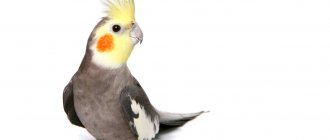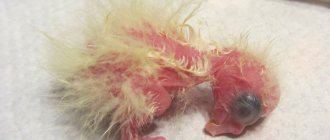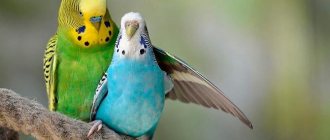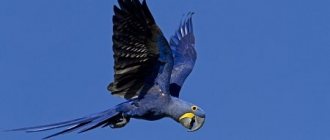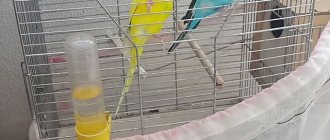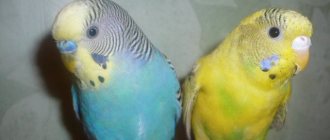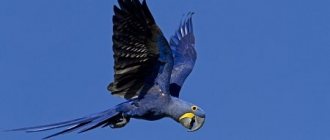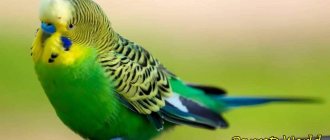Preparing for breeding parrots
In nature, cockatiel birds breed in the fall. At this time, weather conditions are favorable for feeding future offspring. At home, parrots reproduce differently; the owner independently creates the necessary conditions and provides a place for laying eggs. First you need to decide on a pair that will breed the chicks. The male must be healthy; any diseases will negatively affect future offspring. Lame males will not be able to fertilize a female at all; they will not be able to stay on her and will only get hurt.
Professional breeders prefer to look for a male on the side, this way the relatedness of the birds will be excluded. From a genetic point of view, such matings of individuals from the same family will not produce healthy offspring. The age of the parrots also matters; the female cockatiel must be at least two years old; in the early stages, the birds may not carry the egg, since the body is still weak. The male may be six months younger, but one-year-old individuals will not be conscientious fathers. And its role is noticeable for the entire bird family - it helps warm the eggs and feeds weak chicks.
After choosing a pair, you need to prepare the birds mentally for nesting. For a special mood, they need long daylight hours (at least 16 hours). The day should become longer by 10 minutes every day, such additions are carried out within 1.5 months. If it is autumn or winter, artificial lighting is used. The temperature in the room where the birds will nest should not rise above 20 degrees. If this is not controlled, the embryos will cook under the shell.
Close attention is paid to the nutrition of future parents. The male must be fed protein foods and legumes. With the help of such nutrition, the male produces healthy semen. A singing cockatiel is a good sign, which means that the testes are developing normally. The female also needs fruits and a healthy diet; during this period it is forbidden to give vitamins and chemical additives. Otherwise, this will definitely affect the future generation or the eggs will not be fertilized at all. Next, you need to think about your future home and nest.
Matching
Cockatiels are monogamous, in nature they choose a partner for life. To breed in captivity, they also need stable, strong relationships with each other, mutual sympathy. The breeder must give the birds the opportunity to choose: keeping several birds of different sexes in an aviary is suitable for this. This way you are most likely to get a compatible pair in a short time.
When breeding, good offspring of cockatiels are obtained by following several rules:
- parents' health;
- puberty;
- lack of family ties.
Physical health
When selecting sires, you need to carefully monitor their emotional and physical state. The ability to reproduce in the cockatiel parrot remains, despite the illness. But it is impossible to predict what kind of chicks a weakened bird will have. Injured, molting, sick parrots should not be allowed to crossbreed.
Attention! An obese bird must first be brought back to normal condition and then prepared for breeding. An overweight parrot gets tired quickly and cannot sit on eggs in one position for a long time.
Not related
Breeding cockatiels of similar blood is justified only if the goal is to consolidate the characteristics of the mutation (for example, lutino). Inbreeding - the reproduction of same-blooded cockatiels - has unfavorable consequences. Related individuals produce offspring with external defects and violations of basic functions:
- egg production in females and fertilization ability in males are reduced;
- defects of the musculoskeletal system;
- genetic failures;
- weak immunity;
- congenital defects of the beak, wings, paws.
The chicks grow slowly and develop beyond their age. Such young animals rarely produce talented, viable parrots.
Suitable age
Physically and functionally, cockatiels are ready to breed at 9 – 10 months. By this time, their reproductive system has matured, but in fact, cockatiels that are less than a year old are still children. They do not want to take care of the chicks because they themselves are actively growing and spending vital resources.
Breeding young cockatiels at home is not always effective: the female abandons the clutch, and the hatched chicks often die. Careless parents do not have care skills, and the maternal instinct is still poorly developed. The eggs themselves are most likely unfertilized. Problems also arise in immature females: due to inexperience, they cannot push out an egg stuck in the cloaca.
At one and a half to two years, breeding is most fruitful. By this time, the pair of cockatiels will be sufficiently prepared, their bodies will be stronger. Childish playfulness will be replaced by calm maturity, the birds will feel the need to procreate.
On a note! The best producers are considered to be cockatiels from 2.5 to 5 years old. Subsequently, sexual function gradually fades away, and old parrots generally become infertile.
Cockatiel nesting house
Any room for parrots of this species can be selected, the main thing is that the temperature regime is maintained and the appropriate humidity is maintained. Cages and houses must be equipped in such a way that cleaning and disinfection are easy. The presence of ventilation is desirable, but you can simply ventilate the room every day by opening the window. In this case, it is better to cover the cage with a special cover or take it to another room. The slightest hypothermia of the eggs will lead to the death of the embryos.
You will also have to think about a place for flying. Future parents should not sit locked up all the time; this will negatively affect their emotional state. Cages will imitate nests; these are wooden boxes. Only 3 walls are made of wood, the main one is made of mesh, and a door is thought out for the birds to escape. Sawdust, straw or sand are placed at the bottom (layer width 4 cm). To prevent microbes or parasites from appearing in the bedding, add chamomile to it. In nature, these parrots live in dry hollows; in pet stores you can find artificially created wooden houses. It is important to think about the roof of the tub; it should open easily, so you can watch the future chicks without unnecessary noise. Inexperienced bird lovers build nesting houses that are too large, but in a large space the chick can get separated from its mother and freeze.
Houses with cockatiels are cleaned regularly; dirt and droppings can lead to the development of diseases. If the female is weak, she will not be able to breed offspring and all efforts will be in vain. First, the female settles in the future nesting house; she must spend about a day in the new place. This way the bird will get comfortable and have time to look at everything, only then will the future father of her chicks move in with her. You need to carefully watch the cockatiels; if they like each other, the male will begin to court the female. He will sing, perform a mating dance and preen his feathers. Sometimes you have to be patient; mating can last from 7 days to 6 weeks.
Nuances of bird dating
During the period when cockatiels are preparing for breeding, they should first be gradually tamed to each other's company and their behavior should be monitored. It is better to put the female in the cage first so that she can master the new space and feel like its owner. In the future, when breeding cockatiels at home, comfort and proper maintenance will affect the offspring.
The period of male courtship and observation of their “relationships” will be interesting, because they are associatively reminiscent of the manners of people. Birds may quarrel, then they need to be seated. If mutual affection arises, and love is manifested in cleaning feathers, feeding from the beak and all kinds of signs of attention, and the female shows favor towards the cockatiel, the couple has taken place. Doesn’t this “gentlemanly” set of bird courtship copy the behavioral pattern of a person during the mating season?
Activity, vigor and physicality are of great importance in breeding cockatiels, as well as the exclusion of inbreeding, which does not have the best effect on the feathered offspring.
When is it time to breed?
The Corella parrot breeds during the rainy season in its homeland, and with geographical adjustments for the terrain - during the Russian winter (December - January), although the opinions of breeders are divided. The lack of sun in winter does not have the best effect on the chicks, so cockatiels should be equipped with additional light and artificially increase the day to 14 hours a day.
Getting ready for the nesting season
How to breed cockatiels at a time of year that is not the best for them, in order to provide future chicks with comfort and protection from disease? You should start by ensuring hygienic requirements - complete disinfection of feeders and their living space.
Natural instinct requires a nest, and in the wild, parrots make them themselves in the trees. Therefore, in order to get as close as possible to the natural environment, you need to study the details of how to breed cockatiels and, in addition, you should stock up on a special house with an opening lid. The bottom of the house can be covered with sawdust, which the bird itself will assemble into the nest. Perches, perches, a bath for cleanliness, water - these are the necessary parts of the cage.
During difficult times for cockatiels, such as the preparatory period, nesting time, and hatching of offspring, increased nutrition with supplements for birds is necessary. Millet, oats, corn, sunflower seeds, flaxseed, and sprouted wheat will become indispensable in the daily diet.
The period of mating and incubation of chicks
Breeding Corella parrots, in general, is reduced to pair selection, balanced nutrition and an alternative to a nest in the form of an attached house in a cage. Now all that remains is to monitor the behavior of the male.
If a cockatiel desperately “flirts” with a friend and she reciprocates, it means that the mating stage has begun, which, in about a week or two, will be marked by the first egg. After 8 days, perhaps a little later, the female will produce an egg daily (5-7 pieces). Looking at the care and responsibility of the couple for hatching their offspring, one can envy the interest of Corella parrots in reproduction.
The first yellowthroats
And then it happened - the first chicks began to stir in the house. Weak and fragile, they require careful care, like food and warmth. For the first few days, the female herself feeds the yellowthroats with a liquid substance - “bird's milk”, and during complementary feeding, their diet should be diversified with a boiled egg, and the mother-nymph should be offered some boiled grains.
The variety of cockatiel parrots can be discussed from the perspective of advanced breeders, who divide birds when choosing into white and yellow cockatiels, pearl cockatiels, variegated cockatiels, brown, grayish-yellow and small color variations.
Get a bird in your house, and it will delight you not only with its bright plumage, but also surprise you with its devotion and keep you company in all matters.
Cockatiel parrot eggs
If mating is successful, the first egg will appear in a few days. Further, the female will produce them every 10 hours. There can be 2-6 eggs in the nest. The female immediately sits on them so that the embryos do not die from hypothermia. It is important to feed the birds nutritiously during this period; every owner must clearly understand what cockatiels can and cannot eat. During the day, the male sits on the eggs, and the evening and night time belongs to the female. Once again, you should not touch the future offspring, otherwise the birds may refuse to breed them.
Very often the eggs in the nest are not fertilized and chicks will not hatch from them. Non-fertilization occurs for several reasons:
- the cloaca area was covered with abundant plumage;
- poor nutrition of individuals;
- the couple has not yet moved away from the previous nesting (it is necessary to take breaks for 6 months);
- room temperature is too low;
- the birds are sick.
All these factors can be easily eliminated; sometimes you have to call professional breeders for help. If the eggs are fertilized, then after 21-23 days the chicks will appear. During the first days, the female feeds her children with milk from the anterior stomach; this is a very nutritious liquid. After 3-4 days, the female begins to give the chicks solid food (digested grains). During this period, it is advisable to include sprouted grain in the diet of the parent birds.
My birds do this - but it’s too early for them, panic!
Friends, it’s also worth reminding that sex is not always about children. Cockatiels have an egg-laying cycle, which starts under appropriate conditions (warm, light, plenty of food) and a copulation cycle - they simply do this when they are healthy and when everything is fine with them. They like it, and it brings some variety to life, you must agree.
Estimate how much your living conditions contribute to the start of the egg-laying cycle: if you do not overfeed the birds, the apartment is cool, if it’s winter outside, so natural light is low, and you use indoor lighting only when you come home from work - then it is quite possible that the egg-laying cycle you won't start until late spring. But this is all very individual and depends on the latitude in which you live, the location of the apartment windows and a bunch of other factors.
Just because birds are copulating does not mean they are planning to lay eggs tomorrow. It is quite possible that you have a few more months left for them to grow up. So, for example, our birds copulate for pleasure from the New Year (they rested a little after the previous clutch, restored calcium), and they do this until May, when it is already warm and light outside and the female decides to lay her first clutch of the year. In this case, the frequency of copulations increases from once a day to 2-3, and the male begins to look for a nest throughout the apartment, later the female joins him - which means that there are only a few days left before the laying and it’s time for the birds to build a house, otherwise they They'll make eggs wherever they can.
Here is the characteristic behavior of a male when he feels that external conditions are already approaching ideal and his female cockatiel may begin to lay eggs:
Good luck with breeding cockatiels!
www.birdpets.info
When are cockatiel chicks separated from their parents?
Birds will stop feeding their offspring on their own when they reach two months of age. But sometimes the male mates with the female before reaching this age, and the female lays new eggs. In this case, the chicks from the first mating are placed in a separate house. They will have to be fed artificially. But such chicks grow into very tame feathered pets.
If the female does not lay new eggs, then you should wait two months. After the chicks learn to feed themselves and can sit on perches without effort, they can be removed from their parents. They should not be placed in a cage with large birds; large birds will peck at them and cause irreparable harm to their health. A separate cage is used for these purposes; the chicks live in it until they are one year old.
At 8 months, the chicks will exchange their yellow down for feathers; molting lasts about 6 weeks. It is important to care for your feathered babies and keep them clean. Only then will the molting process take place quickly and without much stress.
Budgerigars
Having prepared the cage and nesting box, we place a pair of parrots in them. Watch the birds carefully. If the pair is chosen correctly, the behavior of the parrots will be restless. After 8-10 days the female lays her first egg. The number of eggs in a tab is 6-8, sometimes 10. The eggs of budgerigars are oval in shape, matte white in color. Having laid 1-2 eggs, the female parrot continues laying (every other day).
During incubation, the female is fed by the male. The first chick appears 17-18 days after incubation, the rest appear one after another, usually every other day. Two days before the chicks are born, parrots need to increase the supply of food. Young parrots already fly independently at 35-40 days. At this time, they should be placed in a separate cage.
Jaco
Large parrots breed in aviaries.
It is advisable to provide the couple with free movement from the cage to the room. If you choose a partner successfully, during the nesting season you can see a mating ritual that lasts several days. 2-3 weeks after the mating ritual, the female lays 3-4 eggs in the nest, the intervals between laying eggs are 2 days. The female incubates the clutch for a month. After 2 months (or a little more), the chicks leave the nest and begin to fly. Young parrots should not be separated at this time, as they will still need the help of their parents for some time. Young parakeets can remain in the same cage with their parents until the next nesting season. With proper care, Gray parrots can live up to 100 years.

